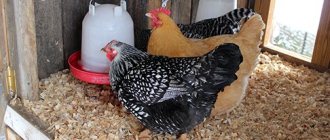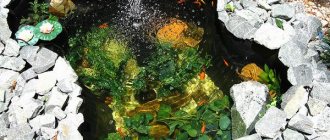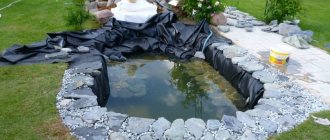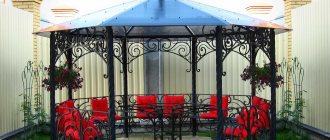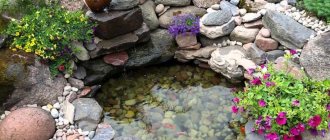- Sorption purification
- Bioplato
Without proper care, any artificial reservoir loses its attractiveness over time: the water becomes cloudy, the surface is overgrown with duckweed, the bottom is covered with silt, mud and an unpleasant odor appear. How to clean a pond at your dacha with your own hands and properly maintain it in perfect condition will be discussed in detail in the article.
An artificial pond serves as an excellent decoration for landscape design even in small areas, but requires constant maintenance
A garden pond is a non-flowing artificial structure in which over time a natural ecosystem (biocenosis) is formed, consisting of aquatic plants, living creatures and microorganisms. Ideally, the biocenosis should maintain its own balance, but, unfortunately, the smaller the body of water, the less stable its ecosystem . The composition of the water in a small pond changes too often and sharply due to temperature fluctuations, the ingress of plant debris and animal waste products, increased evaporation and loss of oxygen.
Changes in the composition of water create favorable conditions for the accelerated development of some plants and microorganisms to the detriment of other inhabitants of the reservoir. As a result, the pond begins to “overgrow” and “silt up,” quickly becoming shallow and turning into a swamp.
To maintain the attractive appearance of a landscape object, owners are forced to regularly intervene in the functioning of the ecosystem and correct negative changes.
Radical cleaning of a country pond is carried out with complete drainage of water. This is a difficult and very labor-intensive undertaking, in which, in addition, loss of aquatic life and vegetation cannot be ruled out. With proper regular care, a medium-sized pond (up to 5 m2) needs to be radically cleaned no more than once every 3-4 years (some owners, by properly “populating” the pond, manage to preserve the natural ecosystem for 10 years or more with minimal intervention).
What is removed from reservoirs
Cleaning ponds and reservoirs is a complex and multifactorial process. It often requires the use of technology and special chemicals.
A pond or lake is an enclosed body of water of artificial or natural origin. Its main advantage and at the same time disadvantage is the weak flow or complete lack of water change.
Depending on the degree of flow, a reservoir may have its own specific pollution. If it is flowing, solid particles can be carried into it with the flow of water. They accumulate, gradually settling to the bottom. This changes the shape of the bottom and banks. As a result, the reservoir becomes shallow, and its coastal zone rapidly begins to become overgrown with aquatic and near-water vegetation.
Thus, the development of a reservoir is influenced by the accumulation of sand, pebbles, and organic matter falling from above. Therefore, cleaning water bodies may include not only the elimination of obvious pollution, but also the removal of useful, but unnecessary garbage - sand, silt, and other organic matter.
Ultraviolet
Installing ultraviolet lamps at the bottom of the pond prevents the appearance of silt deposits in the pond and makes it possible to combat the uncontrolled and ever-growing reproduction and bloom of fine coastal mud, bacteria and viruses and other organisms in the pond.
As a rule, the service life of devices for cleaning ponds does not exceed 2-3 years, and efficiency is ensured by special cleaners that prevent contamination of lamps by overgrown algae.
The power and number of devices for a pond are calculated based on the volume of water, bottom area and depth of the reservoir so that the radiation covers as much water area as possible.
Categories of pollution
Pollution of ponds, lakes, rivers and other bodies of water can be:
- mechanical;
- chemical;
- biological.
Cleaning a pond is not always an easy task.
Mechanical pollution is the accumulation of a large number of solid particles and objects foreign to the pond. Typically, various types of garbage fall into this category. If this is, for example, a pond at the dacha, then mechanical pollutants can be not only all sorts of bottles and other objects made by man, but also sand, pebbles, and clay that have entered the pond in quantities that are not acceptable for the desired state.
Chemical contaminants enter the water in a liquid state or dissolve in the pond, penetrating into it in solid form. Water is a good solvent, so different substances always penetrate into any source. The degree of danger of such solutions depends on their concentration.
Biological pollution is an ambiguous concept. Biological means a living organism or processes involving one. Can organisms be contaminants? Not their waste products, but the organisms themselves?
Pond water can be contaminated by microorganisms. Biological pollution can also include the appearance in large quantities of bacteria that were not found here before. Changing the species balance often affects the composition and properties of water, as well as the appearance of the garden pond.
How to determine the cleanliness of a reservoir (video)
Often different types of pollution reinforce each other. A striking example is the eutrophication of ponds, lakes and even seas. This is the same phenomenon that is called water blooming. At the same time, there may not be plants in it, but previously the water acquired the color of the sky or soil, and now, during the period of eutrophication, it itself acquires a specific shade. The use of the term blooming is due to the fact that the water in the pond turns green due to the abundance of aquatic plants.
Eutrophication – or simply water blooming
Such biological pollution is a consequence of the leaching of highly soluble substances into the reservoir. Most often these are mineral fertilizers. Their appearance in large quantities causes an abrupt increase in the number of algae and bacteria. At the same time, the number of herbivorous organisms increases. As a result, there is little oxygen in the reservoir. The air that comes from the atmosphere cannot compensate for the consumption of oxygen.
After this, fish and other animals begin to die, and the composition of the water changes greatly. The smell of hydrogen sulfide appears. This means that animals and plants die in large numbers, and are replaced first by fungi, and then by anaerobic bacteria that have accumulated in the bottom sediments of the reservoir. After this, your pond looks like a cross between a sewer and a swamp.
How to make pond water clear using pond plants
Planting pond plants is an effective measure to prevent algal blooms. However, you should not limit planting only to coastal plants , which mainly receive nutrients from the soil. Harmful algae require stronger competitors - underwater plants . For example, such as pinnate and cabomba . How does this work? Plants living in the water column, as a rule, do not take root in the soil, but feed directly from the water, depriving harmful vegetation of nutrients. The faster plants grow and reproduce, the less food they leave for blue-green algae and filamentous algae that destroy the reservoir. They are also cold-tolerant and thrive in low temperatures, consuming large amounts of nutrients. Water lilies and lilies also help purify the water in the pond, in addition, they bloom beautifully all summer. Planting such plants ensures natural biological balance in the pond. The rhizome of the nymphea has a dense structure and is a kind of energy store, which the plant stores all summer in order to then successfully survive the cold season. Nymphea leaves also help to successfully purify muddy water in an artificial pond; they provide good shade for fish and remove organic matter from the water.
How to diagnose your pond
Here we will talk about indicators, the recognition of which does not require the involvement of specialists and special laboratory tests. Most often, the reason for cleansing is quite visible and even olfactory changes. Among them:
- Change in color and transparency of water. Most often this is the beginning of the eutrophication process. However, the ingress of water with a large amount of inorganic suspensions can also make the water cloudy. Most often it is clay, soil or fine sand. In addition, the color change may be due to the activity of microorganisms that began to multiply due to the accumulation of organic matter at the bottom.
- Overgrowing of a reservoir with plants. This can occur not only due to chemical pollution, but also due to sediments accumulated at the bottom, which makes the reservoir shallow and well-heated.
- The appearance of a new, most often unpleasant odor. This is usually due to the activity of bacteria or fungi, which begin to actively multiply.
As a rule, these three signs are enough to understand that it’s time to clear the pond of everything that makes it not a beloved little lake, but just a pit of water that, at best, resembles a swamp.
Cloudy water, excessive vegetation, an unpleasant odor - this means it’s time to clean the pond
If you liked the article, please share it
Previously on the topic:
Share
What cleaning methods are there?
Four methods are usually used to clean water bodies: chemical, mechanical, biological and ultraviolet (irradiation with ultraviolet rays).
The chemical method is aimed directly at changing the composition of the water in the pond. It allows you to eliminate chemical contamination in a very short time. This cleaning is done by adding special reagents to the water. Their purpose is not only to change the composition of water, but also to saturate it with oxygen. This method of cleaning a reservoir requires precision, so it is better to involve professionals in the work.
So-called sorbents are also cleaning agents. The minerals commonly used are zeolites. They are placed in special filter chambers and then immersed directly in water. If you put them in special grids, then there will be no problems with changing filters - just pull out the container and replace the zeolites in it.
Purifying minerals have structural porosity, which allows nitrogen and phosphorus compounds to be adsorbed from water. They stimulate the growth of algae and water blooms.
Pond cleaning - the easy way (video)
As a rule, on a dacha or personal plot, reservoirs from a small pond to nearby rivers are surrounded by lands that are in agricultural use. This means that runoff from fields and beds will always end up in the water. For this reason, zeolites should be used once a year as a prophylactic agent. For these purposes, take 0.5-1 kg of zeolite per 1000 liters of water. If the reservoir is in a risk zone and water constantly flows into it, then it is best to keep filters there permanently.
Manual Pond Cleaning
Mechanical cleaning is simply the collection of debris that floats on the surface or lies at the bottom. How to clear a pond of debris if there is no possibility or desire to remove everything manually? The solution to the problem is simple - you can collect foreign objects from the surface with a net, and it is recommended to run a seine from a net with small cells to the bottom.
Cleaning a reservoir can be done with or without draining water. In the first case, the liquid is removed through a drainage ditch into an additional reservoir.
After draining the water, everything that can be considered unnecessary for a given reservoir is collected from the bottom. As a rule, if the pond is small, not only foreign objects themselves are removed, but also organic deposits of natural origin. Do-it-yourself mechanical cleaning of a pond from silt often allows you to open springs, remove layers of organic matter, and remove overgrown plants.
If you start cleaning your pond, then you need to clean the banks as well. Usually, excess plants are removed and accumulated debris is removed. Excess grass is also often removed. All this is done so that the banks of the reservoir acquire clear contours, which can then be marked with ornamental plants, stones and soils.
Ultraviolet water purification system
How to clean a pond using ultraviolet radiation sources? As a rule, a special ultraviolet filter is used for this. It looks like a vessel with a lamp inside. It can be supplemented with a regular filter made by yourself.
The vessel with the lamp is immersed in water. Since he will have to stay in the pond for a long time, he may begin to become overgrown with algae. For them, these radiations are not an obstacle.
To prevent the vessel with the lamp from becoming completely overgrown, it is equipped with a mechanism that cleans off algae. Usually it is a plastic rim, which is driven by a special handle. Moving the rim removes algae, preventing it from accumulating.
All of the above methods are applied depending on the situation - simultaneously or separately from each other. Be that as it may, the removal of mechanical pollutants must necessarily be accompanied by ultraviolet and chemical cleaning.
Tired of washing and drying filters - poison your enemies!
The chemical method is very popular today, since many summer residents prefer not to interfere with the existence of an artificial reservoir, leaving its inhabitants to their fate for a long time. Pour 100 grams into the fish and everything will be fine! Special reagents can destroy unicellular green algae, stabilize acidity, and also saturate the water with the necessary minerals for the growth and development of its inhabitants. Just 80-100 grams of liquid will be enough for a pond of up to 2 cubic meters, and the cost of chemistry against single-celled organisms is only 250-400 rubles per 100 grams. You can use the well-known Crystal Pool or Dolphin with a flow rate of up to 150 grams per 500 liters.
The use of chemicals is practically harmless to all algae that you plant, since the effect is on single-celled organisms. But, as a precaution, it is better not to exceed the dosage, since some substances can stop the development of even more complex life forms than single-celled ones. The dosage of each drug is precisely indicated on the back of the bottles (or tablet packaging).
Mechanized bottom cleaning
The biggest challenge for a pond owner is keeping a large pond or lake clean. Here you will have to use mini dredgers.
Operating principle of the dredger (video)
Such dredging devices are often the only way to clean a large reservoir of silt and other bottom sediments. They can collect everything that has accumulated at the bottom using a powerful soil pump. If we talk about cleaning the bottom of a reservoir with a mini-dredger, which has been overgrown for many years, then such a device turns from an ordinary pump into a suction pump.
Silt and water under high pressure are supplied through a system of pipelines located on the water and the shore. Through a sludge pump and pipeline, all bottom sediments fall into special areas called sludge cards. They are preparing even before the start of work on cleaning the lake. This is a plot of land fenced on all sides by an earthen rampart.
Most often, a specialized Watermaster dredger is used for such work. These machines not only have good performance, but also high maneuverability. They can cope with cleaning any bodies of water, except seas and oceans. It is especially recommended to use them for deepening the bottom. After all, deposits of silt, other organic matter, sand and suspended matter sometimes raise the bottom by more than a meter. As a result, the reservoir becomes shallow and gradually becomes swampy.
As a rule, a mini-dredger is quite enough to tidy up the pond. By removing layers of suspended matter, you will make your pond deep, transparent and beautiful. It can be replanted with ornamental plants.
After a few months, when the turbidity settles, fish of different species can be introduced into it. And then the birds will fly there. After all, nature does not tolerate emptiness even if objects are created by man. A pond or lake always becomes a focal point that attracts different species. In order for an artificial pond to become a part of nature, you need little - good water, a few plants and no chemicals for several years. Then you will enjoy nature, and not tap water in the bath.
Changing water
If a set of cleaning measures no longer helps to restore the pond to its original appearance, a radical method remains - a complete replacement of water.
To thoroughly clean an open pond, it needs to be completely drained from time to time.
When getting started, stick to the following plan :
- If there are fish, frogs or other specially inhabited inhabitants, catch them and transplant them into a separate container.
- If possible, remove ornamental plants.
- Drain all the water.
- Clean the bottom and all internal surfaces of silt and other debris.
- Fill the pond with water and return the plants to their original places.
Fresh water after a complete change can quickly become cloudy. You should not be afraid of this - this is how the work of microorganisms manifests itself, which quickly multiply in a clean reservoir. After a couple of days, the water will clear itself, and after another week, when the biobalance is restored, it will be possible to return fish, snails and other inhabitants to the pond.
Grand total
In order for a pond to live for a long time and delight its owners with the pleasant coolness of the water surface, it must be systematically cared for. At the same time, given the complexity of the ecosystem of reservoirs, the presence of many internal and external factors influencing it, this care should be based on a scientific approach and modern technologies. This can only be ensured by specialists with special knowledge, relevant experience and technical means.
Ratings 0
About the rules for maintaining a pond
Through timely water purification, a number of problems can be solved. But you need to learn and apply certain rules even at the stage of pond construction.
Cleaning with a net
Waterproofing should be carried out using a high-quality film, the service life of which is at least 20 years, because only this will save the reservoir from the penetration of polluting and toxic substances from the soil. For the same purpose, you need to monitor the quality of the concrete, since under certain influences it can crack, which, in turn, will lead to the destruction of the bottom. The purchase of a rigid form for a pond should be accompanied by checking its environmental characteristics so that the same toxic substances do not penetrate into the water.
Vegetation and fish deserve special attention - they must be healthy, since water is a unique environment for the development and spread of various pathogenic factors.



